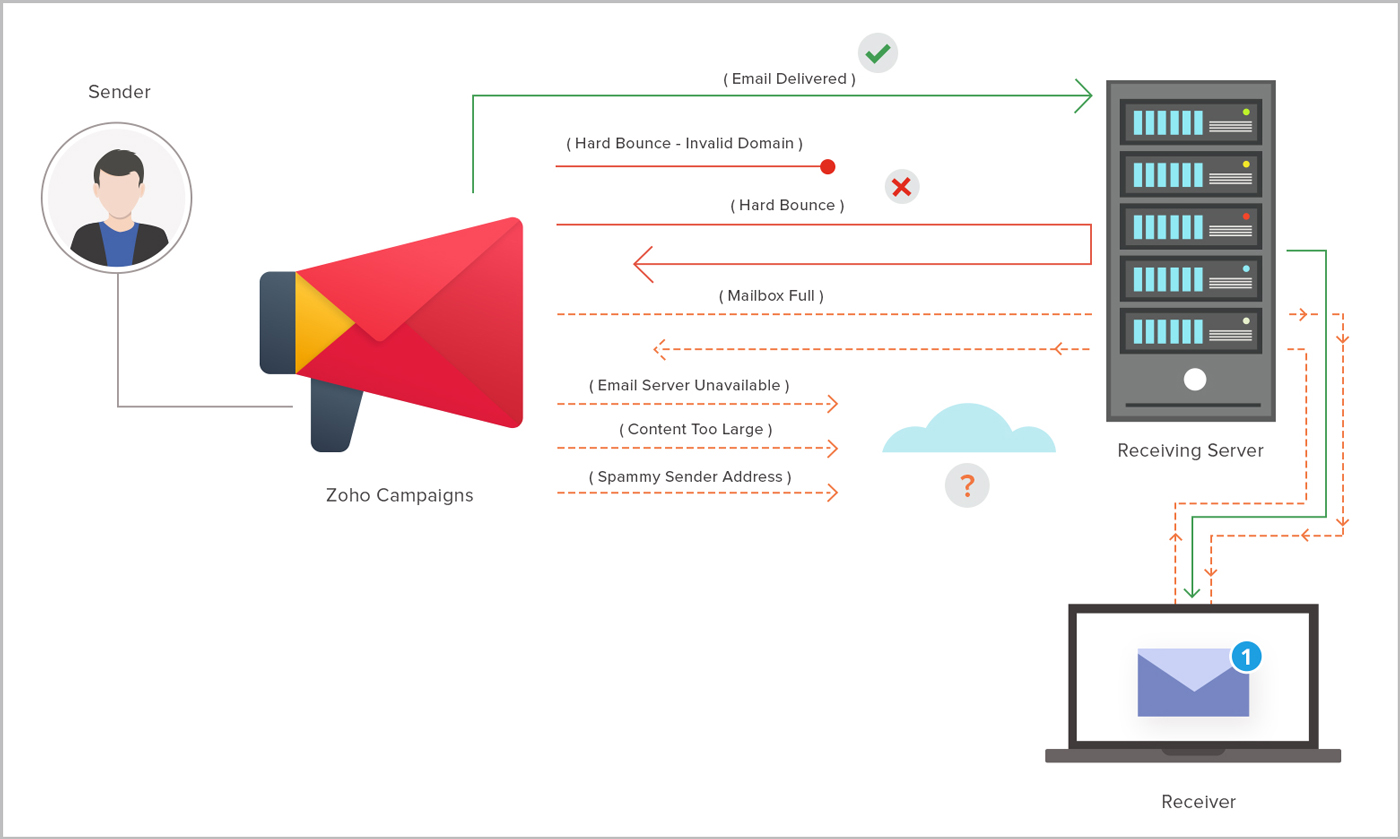Bounces
Bounces occur when sent emails cannot be delivered. Typically, the email server will send you an error message, detailing the reason for the bounce. To learn more about this mechanism, let's walk through the process of sending an email and where bounces fit into the picture.


How are bounces generated?
Once an email is ready and the 'Send' button has been clicked, the system immediately looks up the recipient's domain and mail server. Once our system makes contact, the mail server looks at the message to determine if it will deliver the message. If the message passes through the mail server, then it is considered a success. If that server finds that the email address is invalid or does not exist, then the corresponding bounces will be returned back to our sender's server. This is called a 'hard bounce'.
If the recipient's email address exists but does not have enough storage space to accept the message, then it will bounce back to the sender as a 'soft bounce'. There is a possibility that these bounces may have occurred while the recipient system is busy or unable to handle requests. These emails will be retried within the next five days.
Our system will identify the mail delivery status based on the recipient system's response/status code/message, then generate a report for it.
Significance of bounce rates
Bounce rates are important to determine how many of your emails reach the contacts' inbox and how many don't. They also impact your domain reputation, so it's essential to keep an eye on your bounce numbers. Internet Service Providers (ISPs) and Email Service Providers(ESPs) set a certain threshold for bounce rates; exceeding that threshold may lead to a warning or account suspension.
Bounce types
Bounces come in two categories: soft and hard bounces.
Soft bounces
A soft bounce is just a temporary delivery failure.It does not necessarily mean the email address is invalid or no longer active, so we will continue trying to send emails to these addresses.
These are a few common reasons for a soft bounce:
- Recipient's mailbox is full.
- Email server is temporarily unavailable.
- Email content is too large.
- Spammy content or blacklisted sender address.
In many cases, soft bounces are resolved on their own. Marketers should give utmost priority for these temporary failures in order to avoid a major breakdown in the future. A good marketer must have a plan to handle soft bounces.
If a particular address soft bounces your email three times, it will be considered a hard bounce, and that address will be added to the 'Bounced' list in order to preserve server and IP integrity.
Long story short, soft bounces = temporary deliverability failures.
Hard bounces
A hard bounce means there is a permanent reason for the delivery failure. Generally, the recipients' addresses are immediately added to the 'Bounced' list. Frequent hard bounces bring down the reputation of sending sources drastically.
Here are a few common reasons for an email's hard bounce:
- Recipient email address does not exist.
- Domain name does not exist.
- Typos render the email address invalid. (for example, gnail.com instead of gmail.com)
- Recipient email server has blocked delivery.
- The email address is inactive.
- Email account has been closed.
Hard bounces are quite serious. A raise in hard bounce rate badly affects your sender domain reputation with ESPs and ISPs, and may also lead to blacklisting of your email address.
Long story short, hard bounces = permanent deliverability failures.
How to avoid bounces
- Use double opt-in subscription method when adding contacts to your mailing list.
- Send emails regularly to your contacts and keep your list clean.
- Track your email delivery and make necessary changes to your mailing list immediately.
Related Topics
Related Articles
Email Bounces
Bounces occur when sent emails cannot be delivered. Typically, the email server will send you an error message, detailing the reason for the bounce. How bounces occur Once an email is ready and the 'Send' button has been clicked, the system ...How to Avoid Bounces
Emails that are not delivered and are returned to sender are called bounces. Take a closer look at email bounces to learn why emails bounce. Check the reason for bounces In your campaign report, under Real-Time Campaign Data, you will find the ...How to Avoid Bounces
Emails that are not delivered and are returned to sender are called bounces. Take a closer look at email bounces to learn why emails bounce. Check the reason for bounces In your campaign report, under Real-Time Campaign Data, you will find the ...What will cause a contact to be skipped while sending an email?
Contacts will be skipped when: the email address is invalid there are deliverability issues and soft bouncesWhat will cause a lead to be skipped while sending an email?
Leads will be skipped when: the email address is invalid there are deliverability issues and soft bounces